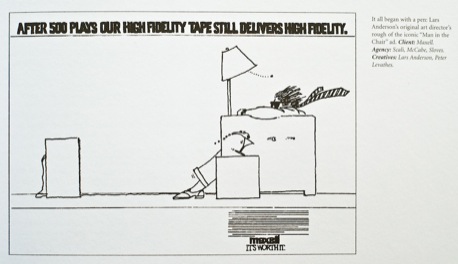The Advertising Concept Book
What makes a good ad? What makes an award-winning creative idea? These days its easy to get distracted by fancy art direction and technological novelties, but when you strip all that away, does the idea still stand up?
This is the essence of Pete Barry’s The Advertising Concept Book (Amazon: US


(Click to enlarge)
“This way, the work is judged by its content, not by its cover. And in terms of my own work, I’d rather have a portfolio of brilliant-thinking roughs than brilliant-looking duffs. Showing fifty years’ worth of rough comps not only helps teachers to explain why an “old” ad is still a great ad, but it also forces students to think now and design later, hence reversing their initial temptation to grab a computer instead of a pencil.”
As someone who teaches interactive media and has run a digital media programme, this gets the biggest of big cheers from me. Learning how to use the tools is important, but not at the expense of the idea. Coming up with ideas and putting your creativity up for criticism isn’t easy. Sometimes it can be soul destroying. But it is part of the process in whatever creative field you are working in.
Over my own years of teaching I have observed two reasons why students cling to the software. The first is that they often mistakenly think it is what will make them money when they leave. That’s true to a certain extent, but there are thousands of other people out there who know how to use Photoshop just as there are millions who can use a pencil. In fact, many people can use Photoshop spectacularly badly.
The second reason is because software skills are something solid and graspable whilst personal, creative development is mushy and scary. It need not be software – there are plenty of people obsessing over the perfect lens or sketchbook. When it feels like you have no ideas and are creatively all at sea, that filter menu in Photoshop looks like an attractive lifebelt, but it can just as easily be a lead weight.
(Click to enlarge)
The Advertising Concept Book is designed primarily for students (and teachers) and provides a well-structured and complete course on advertising, including several exercises that students can try. The book works through the entire process from basic tools, to strategy and campaign executions across all media – print, TV, ambient, interactive, radio and integrated campaigns.
(Click to enlarge)
Saying the book is for students is selling it short. Given some of the terrible advertising that bombards my poor eyeballs every day, there are plenty of advertising and marketing professionals that would get a great deal out of this book. Every new recruit should be given a copy as part of their induction process, perhaps then we’d see some improvement.
“Over time you will become critical of many ads, even awards winners […] Once you start to look at ads properly, it won’t be long before you’ll be wincing with embarrassment as you look back at the ads that you thought were good.”
(Click to enlarge)
Although Barry describes the various roles in advertising, he avoids prioritising art direction or copywriting and points out that this partnership is a blend of skills that overlap and complement each other to create the best ideas. The “think now, design now” mantra remains a consistent focus throughout the book.
The Advertising Concept Book takes all the best parts of fifty years’ worth of awards annuals and, along with the rough comps, adds Barry’s accompanying wisdom, which is both engaging and enlightening. His years of experience – first as an art director at Ogilvy in London and since 2000 as a copywriter in New York and a teacher at Syracuse University – have not gone to waste.
(Click to enlarge)
My father had an advertising agency for many years, which left me pretty cynical about the industry. Yet, I found the book much more engaging than I expected and read it in detail from cover to cover. Some of the approaches to generating ideas have helped me with some recent small projects and certainly sharpened my own creative thinking.
If there is a criticism it is that is that the less classical advertising areas (such as interactive) don’t go into as much detail as I would have liked. This is probably a little unfair because Barry makes it clear from the start that the book is really about straight advertising and I’m being picky because interactive is my own area. (Actually a piece of work for Levi’s by Antirom appears in the book, so I can’t complain).
(Click to enlarge)
If you’re a student you should definitely steal buy this book and if you are involved in teaching design and media, you should buy three copies, one for you and two for your institution’s library. If you are a professional in advertising and are wondering why you haven’t yet won any awards, buy The Advertising Concept Book and you might find out why.
You can support The Designer’s Review of Books by buying The Advertising Concept Book from Amazon (US










